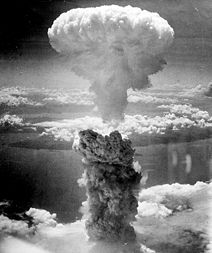
One of the uses of nuclear energy is in the military industry. One of these military uses is the development of nuclear weapons and in particular of the atomic bomb.
The operation of the atomic bomb varies depending on the design. However, all designs are based on the generation of nuclear chain reactions to produce a nuclear explosion.
The atomic bomb has a devastating capacity much greater than any other type of bomb and is considered a weapon of mass destruction. For this reason, the United Nations promoted the Nuclear Non-Proliferation Treaty that was developed at the end of the cold war. The purpose is to limit and control the development of nuclear weapons.
So far, the atomic bomb has only been dropped on the Japanese cities of Hiroshima and Nagasaki during WWII. 2020 marked the 75th anniversary of the launch.
What countries have the atomic bomb?
The countries that have enough technology to develop the atomic bomb are: Russia, the United States, the United Kingdom, France, China, India, Israel, Pakistan, North Korea, South Africa and Spain.
Types of atomic bombs
Uranium bomb
The uranium atomic bomb is based on the presence of a subcritical mass of uranium (the isotope Uranium-235). A greater quantity of uranium is added to this mass to reach a critical mass and generate a nuclear chain reaction.
In addition, this bomb also has other neutron generators so that the chain reaction is sustained and leads to a nuclear explosion.
The destructive effect of these reactions is due to the mechanical shock wave, radioactivity and the thermal wave generated.
Plutonium bomb
In the plutonium atomic bomb, the fissile mass is surrounded by conventional plastic explosives to compress the metal (plutonium-239 isotope).
The compression of the plutonium increases the density of the material causing an uncontrolled nuclear chain reaction.
The consequences of the plutonium nuclear bomb are explosion and total destruction within a limited perimeter. Also, the surrounding environment becomes highly radioactive.
Hydrogen or thermonuclear bomb (H bomb)
In the hydrogen bomb the process is reversed. It is about the fusion of the nuclei of light atoms that even gives off a much higher specific heat energy. However, to start the fusion reaction, very high temperatures are necessary, which is achieved by combining an atomic bomb with a hydrogen bomb.
To start this type of chain reaction, a large contribution of energy is necessary. Usually this type of nuclear bomb contains a fission nuclear bomb that acts as an initiator.
Unlike atomic bombs, hydrogen bombs do not contaminate the explosion site with radioactive products.
Neutron bombs (N bomb)
The neutron bomb is a nuclear weapon derived from the hydrogen bomb. In the neutron bomb the percentage of energy obtained by fission is much lower than in the hydrogen bomb.
During detonation, the neutron bomb emits a large number of neutrons with very high energy levels, and therefore with great penetration capacity.
Consequently, the proportion of ionizing radiation is up to seven times greater than that of a hydrogen bomb (H-bomb). These radiations are fundamentally X-rays and gamma radiation of high penetration during a few seconds. Much of this radioactivity is of much shorter duration (less than 48 hours) than what can be expected from a conventional fission bomb.
When an N-bomb is detonated there is little destruction of structures and buildings, but a lot of damage and death of living beings by radiation.
The atomic bombs of Hiroshima and Nagasaki
Following the discovery of fission towards the end of 1938, a number of scientists devoted themselves especially to studying the phenomenon of nuclear energy. In 1939, the United States launched the Manhattan project for the development of the atomic bomb.
On December 2, 1942 they managed to start up the first nuclear reactor, with the direct intervention of Enrico Fermi. The start-up of this reactor was the basis of the first serious calculations of the energy that could be released in a nuclear bomb.
 The works for the achievement of the first nuclear fission bomb were carried out in Los Alamos under the direction of Jacob Robert Oppenheimer. The first test of the nuclear bomb took place in Alamogordo (New Mexico) on July 16, 1945. The fuel used was plutonium-239.
The works for the achievement of the first nuclear fission bomb were carried out in Los Alamos under the direction of Jacob Robert Oppenheimer. The first test of the nuclear bomb took place in Alamogordo (New Mexico) on July 16, 1945. The fuel used was plutonium-239.
Finally, American President Harry Truman ordered the dropping of two atomic bombs on Japan to end World War II:
-
The first atomic bomb was called Little Boy. This first bomb was uranium-235 and was dropped on the city of Hiroshima (Japan) on August 6, 1945.
-
The second nuclear bomb was called Fat Man. This second bomb was made of plutonium and was dropped on August 9 on the Japanese city of Nagasaki.